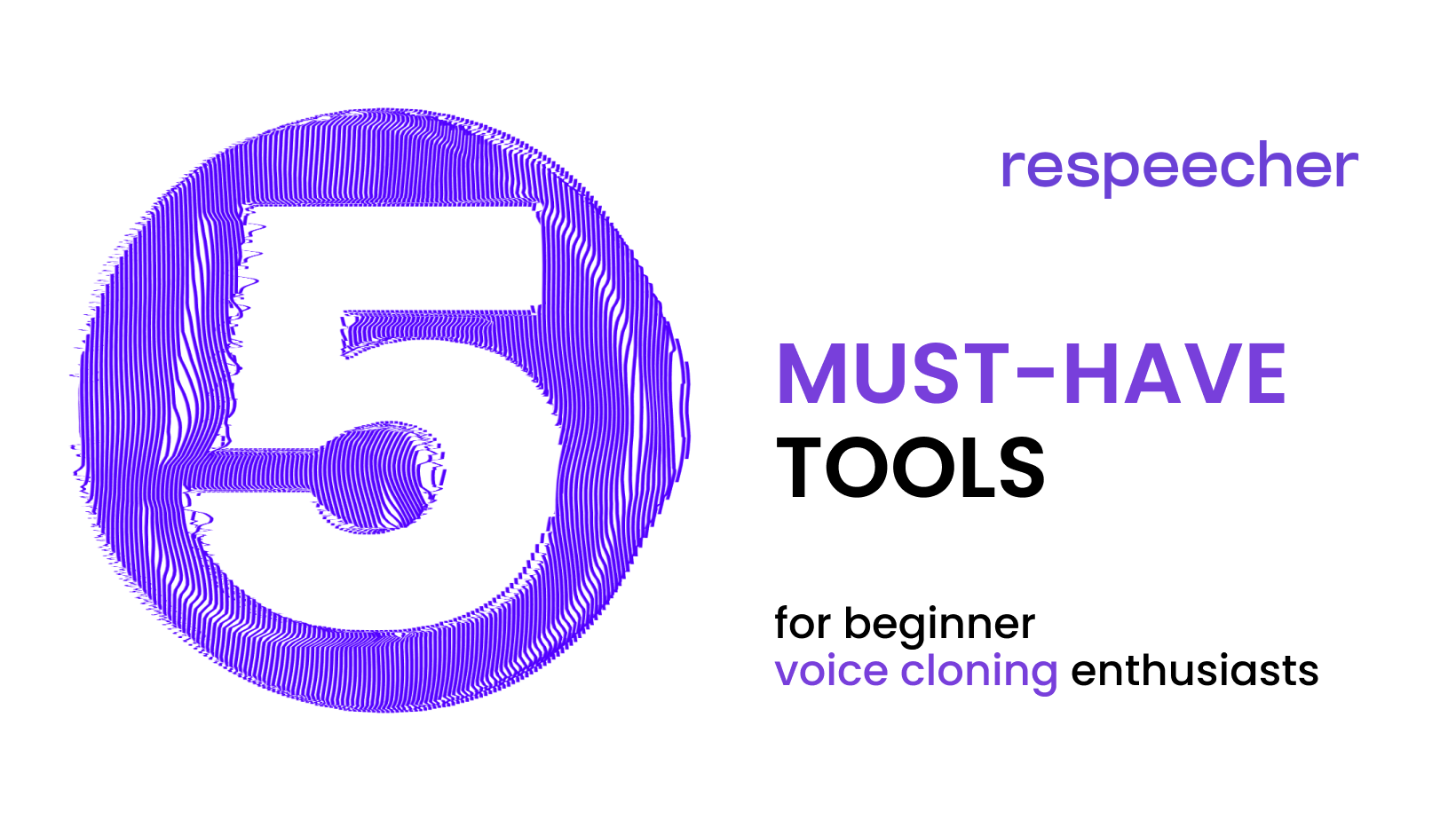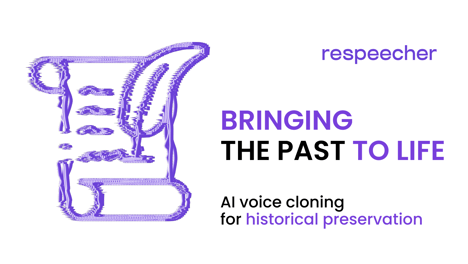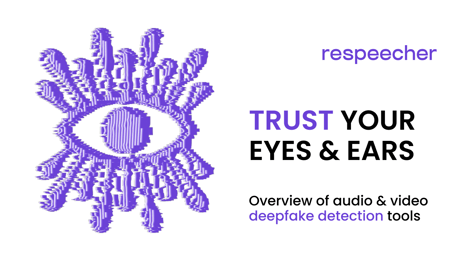5 Must-Have Tools for Beginner Voice Cloning Enthusiasts

Voice cloning, or creating a digital replica of a person's voice, has rapidly evolved, opening up exciting opportunities for beginners interested in audio and voice changing. Still, as with any powerful technology, it's crucial to approach voice cloning tools with a sense of responsibility and ethical awareness.
The ability to replicate someone's voice can be both thrilling and potentially harmful if misused. It's essential to always obtain consent from the person whose voice you are cloning and to use this technology in ways that respect privacy and integrity. Let's discuss what is needed for beginners to get started.
Essential Tools Overview
The first essential step is acquiring the right AI audio recording equipment. High-quality audio recordings are crucial for creating accurate and lifelike voice clones. Here are some basic tools you will need:
-
Microphone: A USB condenser microphone is a great choice for beginners due to its ease of use and affordability.
-
Pop Filter: A pop filter is essential to ensure your recordings are clean and free from plosive sounds (like "p" and "b").
-
Headphones: Over-ear, closed-back headphones are generally preferred for their noise-isolating properties.
Setting up your home recording studio also involves choosing the appropriate sound recording software. This software is vital for capturing and editing high-quality audio tracks. Here are some essential software options to consider:
-
Audacity: This open-source software is perfect for beginners. It's free, available on all operating systems, and offers a range of basic to advanced editing tools.
-
GarageBand: Available exclusively for Mac users, GarageBand is user-friendly and comes with a variety of virtual instruments and loops, ideal for music production.
-
Adobe Audition: A more advanced option, suitable for those looking to invest in professional-grade audio editing capabilities.
Top Voice Cloning Tools
Basic Voice Synthesizer
Text-to-Speech conversion available on Respeecher Marketplace is a great choice for beginners interested in voice synthesis. It's straightforward to use and offers high-quality voice synthesis across multiple voices. For English voices, Respeecher also offers different narrations styles.
For more control over the output voice’s emotions, you can try Speech-to-Speech conversion - with it, users can create various voice types from their own voice. Respeecher Marketplace offers a wide selection of pre-trained AI voices that can be customized to fit different needs, from character voices in games to video narration.
You can also integrate Respeecher’s AI voice synthesizer capabilities into applications via API - it’s perfect for developers new to voice synthesis technology.
Editing Software
Audacity is a powerful, open-source audio editing software that beautifully complements voice cloning tasks. It offers a range of features, including multi-track editing, audio effects, and noise reduction, which are essential for refining your voice recordings. Audacity's user-friendly interface and extensive online tutorials make it an excellent choice for beginners who want to polish their audio clips before using them for voice cloning.
Speech Analysis Tools
Praat is a versatile tool for analyzing and tweaking speech patterns, which is crucial for voice cloning enthusiasts who want to fine-tune their synthetic voices. It offers detailed acoustic analysis and visualization features.
Ethical Considerations in Voice Cloning
One of the most critical aspects of ethical AI voice cloning is obtaining explicit consent from the original voice owners. Consent is not just a legal requirement but also a moral imperative to respect individuals' privacy and autonomy. Consent should be documented and involve a thorough explanation of how the voice will be used, the extent of its application, and any potential implications.
The potential for misuse in voice cloning is significant, ranging from impersonation to fraud. Therefore, generative AI tools like those offered by Respeecher incorporate measures to ensure ethical usage. Respeecher requires moderation and explicit consent before providing voice cloning services - you can read more about it on our Ethics page. This approach helps prevent the technology from being used maliciously, such as creating deepfakes or unauthorized voice replications.
Navigating the legal landscape of voice cloning involves understanding and complying with various laws and regulations. These can vary significantly by region but generally include intellectual property rights, privacy laws, and data protection regulations.
For instance, unauthorized voice cloning can violate an individual's right to publicity, which protects against the commercial use of someone's likeness without permission. Additionally, privacy laws such as the General Data Protection Regulation (GDPR) in Europe impose strict rules on how personal data, including voice recordings, can be collected, stored, and used.
Getting Started with Voice Cloning
Creating an effective workspace is essential for successful voice cloning for beginners. Here are some tips to set up a home studio or workspace:
-
Choose a Quiet Space: Select a room with minimal background noise and good acoustics. Avoid areas with a lot of echo or external noise.
-
Soundproofing: Use foam panels, heavy curtains, or carpets to reduce noise and echoes. Soundproofing helps in capturing clear and high-quality audio recordings.
-
Organized Setup: Arrange your equipment, such as microphones, pop filters, headphones, and audio interfaces, in an organized manner. Ensure all cables are neatly managed to avoid clutter and interference.
-
Comfortable Environment: Make sure your workspace has adequate lighting and seating. A comfortable environment will help you stay focused during lengthy recording or editing sessions.
-
Proper Ventilation: Ensure your workspace has good ventilation. This is important for maintaining a comfortable temperature and preventing equipment from overheating.
Taping into various learning resources to start voice cloning is beneficial. Here are some recommended tutorials, courses, and communities:
-
YouTube Tutorials: Many creators on YouTube offer step-by-step tutorials on voice cloning, audio editing, and using specific tools like Audacity and Replica Studios. Channels like "Booth Junkie" and "Mike Russell" provide excellent audio recording and editing tips.
-
Online Courses: Platforms like Coursera, Udemy, and LinkedIn Learning offer courses on voice technology, AI, and audio engineering. Courses such as "Voice Over Masterclass - The Official DIY Guide to Voice Acting" on Udemy can be particularly useful.
-
Books and Articles: Reading books and articles on AI, machine learning, and audio production can deepen your understanding of the technical aspects of voice cloning. Books like "Deep Learning" by Ian Goodfellow and "The Art of Voice Acting" by James Alburger are great starting points.
-
Workshops and Webinars: Participate in workshops and webinars conducted by experts in the field. These interactive sessions often provide hands-on experience and direct access to professional advice.
Real-World Applications of Voice Cloning
Voice cloning software offers many creative and legitimate applications across various fields. Here are some notable examples:
Entertainment: Voice cloning is revolutionizing the entertainment industry by enabling the recreation of voices for movies, TV shows, and video games. For instance, Respeecher has worked on projects where they ethically recreated the voices of iconic characters, such as synthesizing a younger Luke Skywalker's voice for Disney+'s The Mandalorian or reviving the Hungarian voice of Darth Vader.
Podcasts: Podcasters use voice cloning to create unique characters and enhance storytelling. By cloning their own voices or creating entirely new ones, podcasters can add a new dimension to their audio content. Respeecher has collaborated with a popular YouTube channel Jolly, giving it new ways to amaze audiences.
Education: In the educational sector, voice cloning is being used to create engaging and personalized learning experiences. Teachers can clone their voices to provide consistent and scalable instruction or educational apps can offer a variety of voices to cater to different learning styles. Respeecher has partnered with Atomic Entertainment, an Emmy award-winning production company, reproducing children's voices for educational projects. Respeecher and Highwire have also partnered to teach children aged 9-14 about critical thinking in the digital age.
There are many ways to use beginner-level voice cloning tools. Indie game developers can create unique AI voices for their game characters. YouTube creators can generate a synthetic narrator for their videos.
Small businesses can develop a virtual assistant that interacts with customers on their website. Authors can also narrate their own books like Reid Hoffman, co-founder of LinkedIn, did it with "Impromptu: Amplifying Our Humanity Through AI".
Beginner-level voice cloning tools can be used ethically and creatively to enhance various projects. Individuals and businesses can leverage voice cloning technology to innovate and improve their offerings by prioritizing consent, transparency, and responsible use.
Conclusion
We discussed everything necessary for those new to the field, starting with basic audio equipment like microphones, pop filters, and headphones and moving to user-friendly voice cloning software. Now that you have a comprehensive understanding of the must-have tools for voice cloning, it's time to begin.
Explore generative AI applications, but always remember the ethical considerations. Ensure you have explicit consent when cloning voices, avoid misuse and stay informed about the legal landscape. By prioritizing ethical practices and continuous learning, you can responsibly harness the power of voice cloning technology to innovate and create. To learn how to start, try Respeecher AI speech generator today.
FAQ
Respeecher is a great AI voice cloning tool that has been acknowledged with Emmy, Clio, and multiple Webby awards.
Known for its high-quality output and ethical practices, Respeecher helps deliver authentic voices across multiple industries, such as films, TV, animation, music, dubbing & localisation, healthcare, cybersecurity, and call centres.
Voice cloning involves creating a digital replica of a person's voice using advanced AI and machine learning algorithms. The process requires high-quality audio recordings, voice synthesis software, and tools for editing and fine-tuning the cloned AI-generated voice to achieve a natural and realistic sound.
To train AI for voice cloning, you must collect high-quality audio recordings of the target voice. These recordings are then used to train machine learning models, which analyse and replicate the voice's nuances. Many AI content creation tools, like Resemble.ai, offer user-friendly interfaces to streamline this training process.
In theory, anyone with access to sufficient recordings of your voice and the right AI tools for content creation can attempt to clone it.
However, ethical and reputable services like Respeecher require explicit consent and moderation to prevent misuse and ensure the responsible application of voice cloning technology.
Voice cloning itself is not illegal, but its use is subject to legal and ethical considerations. Unauthorised cloning of someone's voice can violate privacy, intellectual property, and right of publicity laws.
At Respeecher, we always obtain explicit consent and adhere to legal guidelines when using voice cloning technology for realistic AI voice creation.
Glossary
Voice cloning
Creating a digital replica of a person's voice using AI and machine learning to mimic speech patterns and nuances.
AI voice
AI ethics
Ethical principles governing the development and use of artificial intelligence technologies, ensuring fairness, transparency, and responsible deployment.
Deepfake generator
Deepfake
A manipulated AI audio or video that appears real, created using deep learning techniques to alter or replace elements of an original media, often for deceptive purposes.

- AI voice
- voice cloning software
- AI voices
- voice synthesizer
- AI voice generator
- realistic voice generator
- AI content generation
- AI generated voice
- Respeecher for Business
- AI voice synthesizer
- AI speech generator
- voice ai
- voice over AI
- generative AI tools
- AI speech
- realistic AI voice
- voice AI generator
- ai sound generator
- ai audio
- AI audio generator
- voice generator AI
- AI tools for content creation
- content generation AI
- AI voice replicator
- AI content creation
- AI tool for content creation
- AI content creation tools
- AI powered content creation
- generative AI applications
- voice cloning for beginners
- voice cloning tools
- beginner audio software








